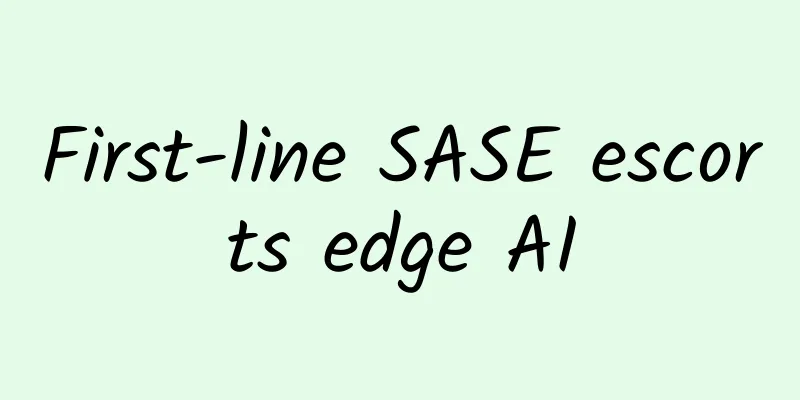First-line SASE escorts edge AI

|
When data sharing and circulation become a rigid demand, originally isolated business networks break boundaries and move towards integration. When an enterprise's data center is no longer the de facto "data center", edge computing becomes just one of the many services that users need to access. As digital technologies such as cloud computing, IoT, and AI spread rapidly, enterprise network architectures are becoming increasingly complex, and traditional network security architectures are no longer sustainable. How to improve the flexibility and scalability of the network under the new situation, and how to build a unified security line of defense for "cloud, network, edge" from the perspective of the new IT architecture have become key issues in the current enterprise WAN construction. Recently, after the 6th SD-WAN & SASE Conference and Cloud Network Conference, 51CTO interviewed Li Xiaodong, product manager of First Line, to discuss the above topics. From the perspective of First Line, we can not only see the innovative path of enterprise network architecture upgrades, but also get a glimpse of the trend changes in enterprise cloud-edge security protection. Advancement of network security architecture under the wave of digitalizationThe wind starts from the tip of a blade of grass. In the ICT industry, the development of one or several key technologies often leads to changes in the sub-sectors in which they are located, which in turn drives the industry forward in collaboration, forming a joint force to push the industry into a new development cycle. In the current development of enterprise wide area networks, SD-WAN and SASE are two roles that cannot be ignored. Gartner's latest 2023 China Information and Communication Technology Maturity Curve shows that SD-WAN is in a steady rise in the Chinese ICT market after the bubble burst. In comparison, SASE, a concept proposed by Gartner in 2019, is newer to Chinese enterprise users. SASE does not refer to a specific technology. It is more like a part of the evolution of the larger network security architecture described by Gartner. As a product of the combination of WAN cloudification and network security, it provides a new solution to the traditional network security framework torn apart by cloud computing and mobile computing. Some people may say that SD-WAN technology itself can provide a certain level of basic security for the enterprise network environment, so why is SASE needed? In this regard, Li Xiaodong explained: "With the increase in branch offices, mobile devices and cloud services, the complex and dynamic network environment requires more flexible and efficient network security solutions. In recent years, the digitalization of enterprises has accelerated, but at the same time, many new security threats have also followed one after another. They have the characteristics of fast mutation speed, strong concealment and persistence, and require more rapid response and disposal of security protection." As this network environment evolves, people are gradually realizing that relying solely on traditional SD-WAN security features may not be enough to defend against modern network threats. First-line's deployment of the SASE service architecture is also to add stronger security on the basis of SD-WAN. By integrating multiple security services such as firewalls, CASB, and ZTNA into a comprehensive resource pool, enterprises can obtain comprehensive network and security functions. SASE roots the security gene in the technical architecture system and network, and truly establishes an endogenous security system to better cope with increasingly complex security threats. AI helps us explore the way to turn a "double-edged sword" into a good oneIn recent years, AI applications represented by ChatGPT have become very popular. While these new technologies and applications have improved production and living efficiency, they have also provided new carriers for cyber attacks, making their implementation more flexible and more covert, making threat detection and tracing more difficult. At present, many security threats have begun to use AI to achieve higher attack efficiency. For example, attackers use AI to generate malware to better evade detection and defense; or use AI to perform network attacks, such as DDoS attacks, SQL injection attacks, and malicious traffic attacks. AI is a double-edged sword, and how to use it is related to the sword holder's way. In this context, DYXnet has also begun to explore its own ways - working with leading security partners, connecting to cloud-based intelligent engines, and using smarter detection methods to respond to various new security threats. With the support of AI technology, intelligent threat detection and protection can be achieved. For example, using AI technology for behavioral analysis and machine learning can more accurately detect abnormal activities and potential threats in the network, especially improve the ability to identify unknown threats. Li Xiaodong described the process as follows: When a new virus is generated, it can be detected at multiple levels through the cloud-based intelligent engine. After the threat is detected, it can learn autonomously and synchronize the results to the SASE POP of the entire network to achieve overall network immunity. In other words, the first-line SASE can integrate real-time threat intelligence, and then perform agile interception based on massive threat intelligence to deal with emerging threats and attacks. Explore the layout of edge AI and “land on the beach” in cloud-edge-device integrationFor Dianxian, which already has services and resource capabilities such as SD - WAN , SASE , and edge cloud , and has observed the rooting of AI in thousands of industries, exploring the layout of "edge AI" seems to be a natural choice. "By using edge AI, we can process the data generated by edge terminals in real time to shorten latency and processed traffic, reduce network bandwidth usage, and then leverage the flexibility of edge computing deployment to bring certain cost advantages." Li Xiaodong explained the original intention of First Line to build an integrated cloud-edge solution. IDC predicts that by 2025, there will be 41.4 billion IoT devices in the world, generating 73,147 EB of data, of which about a quarter will be generated in real time . China's 14th Five-Year Plan also clearly proposes to "coordinate the development of cloud services and edge computing services." Whether from market trends or policy orientations, we can see that cloud-edge-end integration is bound to become an important evolutionary direction in the future. Li Xiaodong introduced that with the support of the first-line cloud-edge-device architecture, AI application capabilities can be transferred to the edge cloud and the device side for linkage, providing enterprises with on-site AI services and responding to needs intelligently and agilely. However, security protection around this innovative interconnected scenario should not be ignored . In response to this challenge, DYXnet has also made corresponding plans: on the one hand, it establishes a security domain based on the SASE architecture, and creates an edge computing domain with public cloud + edge cloud + SD-WAN. Based on the linkage of the two domains, it realizes the flexible scheduling of edge AI and SASE capabilities, helping enterprises to carry out multi-scenario protection and smart office ; on the other hand, it promotes the SD-WAN & SASE management platform to achieve the adaptation and integration of cloud AI applications, edge cloud and smart terminals, and drives with refined strategies to uniformly and visually manage the data interconnection and security situation of the entire chain of heterogeneous IT architecture. With a secure network, the development of edge AI will have room to go to the next level . Conclusion: Gold will appear after all the sand is blown awayIf SD-WAN and SASE are the key variables in the current transformation of enterprise wide area network technology systems, then AI is the catalyst for accelerating transformation, and cloud-edge-end integration is the beachhead that many companies are aiming for in this wave. From the perspective of the front line, we can find that they are continuously extending the boundaries of "cloud network security" service capabilities and striving to open up the security and intelligent empowerment of "cloud network edge". The whistle for this beachhead landing game has already sounded. As for the end of the game, we have reason to believe that, just like any previous wave of technological change, it will be a story of "although it is hard to sift through the sand, gold will be found after blowing through the sand." |
<<: Let’s talk about what CDN is. Do you know these characteristics?
Recommend
What exactly is HTTP3 that international companies such as Google are beginning to support?
There has been a lot of news about HTTP/3 in rece...
Ministry of Industry and Information Technology: China's 5G investment reached 184.9 billion yuan in 2021
On January 25, China's Ministry of Industry a...
5G: Number of terminal connections exceeds 200 million
2020 is the first year of large-scale constructio...
Five API Gateway Technology Selections, yyds
This article intends to discuss gateways around s...
What IoT strategies do global operators have?
After several years of preparation and developmen...
2017 Network and Security Technology Keywords
[[181163]] With the rapid development of network ...
With HTTP protocol, why do we need Websocket?
[[428410]] WebSocket is a full-duplex communicati...
Wu Hequan, Academician of the Chinese Academy of Engineering: The communications industry needs to adjust its development strategy
August 30 news: The 9th "International Sympo...
LisaHost New Singapore Residential Native IP Hosting 10% Off Starting from $43/month
Lisahost has launched a new Singapore VPS host, S...
ZJI newly launched Hong Kong one machine three lines (Kwai Wan/Alibaba Cloud/Huawei Cloud) server, 20% off monthly payment starting from 800 yuan
ZJI is a well-known hosting company in the WordPr...
4G is a knife, and 5G is a Swiss Army knife?
[[189173]] If the 4G network is a knife that can ...
[Closed] NextArray: $1.09/month KVM-1GB/10GB/1TB/Dallas Data Center
[Closed] NextArray is a foreign hosting company fo...
Apple iPhone is required to shut down 2G network due to too many loopholes: Android has already done it in advance
The GSM 2G network has been around for more than ...
Kunpeng spreads its wings and Zhejiang has great potential | Kunpeng Application Innovation Competition 2020 (Zhejiang Division) briefing session is recruiting heroes!
At 14:30 on July 31, 2020, the Kunpeng Applicatio...
China Mobile's TD-SCDMA network withdrawal begins: Fujian has taken the lead
[[259267]] Recently, the Fuzhou Radio Management ...









